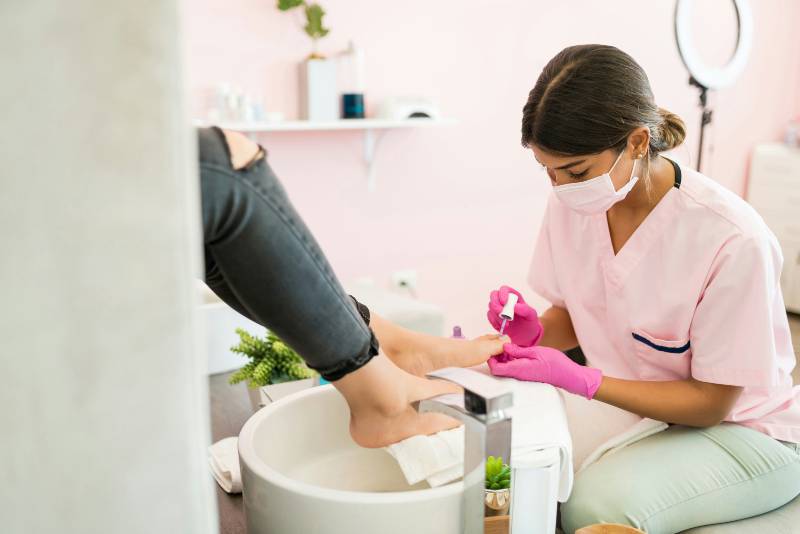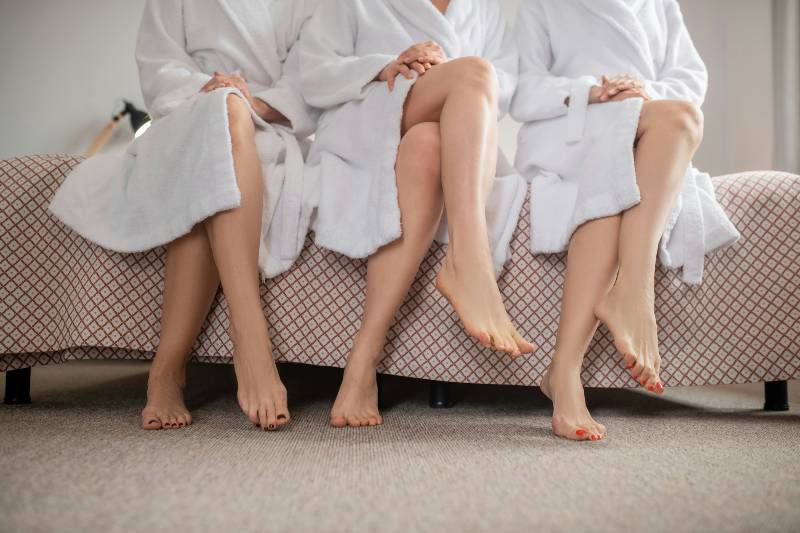Getting a pedicure is like taking your feet to a mini spa. It’s your chance to sit back, relax, and let someone else take care of you for a little while.
But a pedicure isn’t just about getting your toenails painted. It’s a full treatment for your feet that keeps them healthy and looking great.
Ever wondered what exactly goes into this foot-pampering session, or how often you should book one to keep your feet in their best shape?
Well, we’ve got the scoop on everything pedicure-related, from what a full service includes to the signs that tell you it’s time for your next visit.
What A Full Pedicure Typically Includes?
When you go for a full pedicure, it’s more than just putting on nail polish. Here’s what you can expect:
- Soaking: Your feet are placed in warm, bubbly water to relax and soften your skin.
- Exfoliating: A scrub or special tool removes dead skin, mostly from your heels or any rough spots.
- Cuticle Care: Gentle pushing back and trimming, if needed, to make your nails look neat.
- Trimming and Shaping: Cutting your nails the right way and filing them into shape.
- Moisturizing: A nice lotion or cream is massaged into your skin to keep it soft.
- Polishing: The fun part where you pick a color, and they paint your nails.
These steps help keep your feet healthy, looking great, and can even make you feel more relaxed.
How Often To Get A Pedicure?
Now that you know what’s included in a full pedicure, the big question is, how often should you book your next appointment?
For most people, every 4 to 6 weeks is a good schedule to keep your feet in tip-top shape. Why this timeframe? It strikes the perfect balance between keeping your nails well-groomed and managing any tough skin, without overdoing it.
The frequency of getting a pedicure also depends on:
- General Health: If you’re mainly getting pedicures to maintain healthy feet, a monthly visit is usually plenty.
- Nail Growth: Nails grow at different rates, but waiting too long can lead to overgrown nails, which can cause issues.
- Seasonal Changes: In the summer, you might go more often because you’re wearing sandals and your feet are on display. In the winter, you can go less often if you prefer.
- Personal Preference: Some enjoy the relaxation and may go more regularly, while others might wait until they see signs that they need a pedicure.
Consider your lifestyle, budget, and how much you enjoy the pedicure experience when deciding how often to go.
8 Signs You Need a Full Pedicure

If you’re trying to gauge when to book your next pedi, there are some signs that your feet need one. It’s not only about the aesthetics; these signals can also indicate that neglecting a pedicure could impact your foot health.
1. Noticeable Nail Growth
As your toenails grow, they can potentially disrupt the comfort of your footwear and even alter your walking pattern. But that’s not all. Nails that are too long are more prone to becoming ingrown, which can lead to painful infections.
If you notice your toenails are starting to curl over or are pushing against the inside of your shoes, it’s definitely time for a trim and shape at the spa.
2. Chipped or Faded Nail Polish
We all love the look of freshly painted toenails, but over time polish chips or the color fades due to exposure to sunlight, sand, or pool water.
There’s also the “gap” issue where the polish is still intact near the ends, but there’s an obvious gap at the cuticle from where the nail has grown out.
If you’re seeing these signs and feeling self-conscious about your toes, it may be time to let a professional remove the old polish.
3. Dry, Cracked Heels
Heels often bear the brunt of dryness, especially in harsh climates or from wearing open-back shoes. If they start to feel rough or you notice a white, hardened layer of skin, or worse still, if you have deep cracks that might even be painful, these are clear indications that your feet need some TLC.
A pedicure can help to exfoliate and hydrate these areas, preventing fissures from becoming deep enough to cause bleeding or infection.
4. Corns and Calluses
Corns and calluses may not only look unsightly but can also be uncomfortable. These thickened layers of skin develop from your feet’s defenses against pressure and friction.
During a pedicure, a professional can safely reduce the thickness of these areas, providing relief and improving the appearance of your feet.
5. Unpleasant Foot Odor
Feet can start to smell for a number of reasons, including sweat, bacteria, or even fungi. Regular pedicures help to keep the feet clean and reduce odor.
If you notice a consistent smell coming from your feet, despite daily washes, it could be time for a deep clean that comes with a professional pedicure.
6. Swollen or Sore Feet
If you’ve been on your feet more than usual or worn uncomfortable shoes, you might experience swelling or soreness that makes every step painful. While this can sometimes be alleviated with rest and elevation, a pedicure can also help.
The massage that’s usually part of a pedicure improves circulation, which can reduce swelling and relieve soreness. When your feet ache, it’s a sign that you should let a professional soothe that discomfort away.
7. Inflexible Toenails
Toenails can become thick and hard to trim at home, making it difficult to maintain proper foot hygiene. Infrequent cutting might cause nails to grow into the skin, leading to discomfort and possible infection. Regular pedicures prevent these complications by keeping nails neat and at an appropriate length.
8. Emotional Well-being
Lastly, don’t underestimate the emotional signs. Feeling stressed, run down, or in need of some personal time can also be signs it’s time for a pedicure. This pampering isn’t just for your feet – it’s a soothing experience that benefits your whole self.
A pedicure can be the perfect excuse for some ‘me time’ and to unwind from life’s daily pressures.
Benefits of Routine Pedicures
Making pedicures a regular part of your self-care routine not only leaves you with pretty toes but comes with a plethora of advantages for your foot health, personal hygiene, and even mental well-being.
Maintain Foot Health
Routine pedicures keep nails trimmed, skin exfoliated, and calluses controlled. This proactive foot care can prevent common issues like ingrown toenails and fungal infections.
Regular exfoliation during pedicures also helps to prevent the cells from accumulating on your feet, which can lead to corns or bunions.
Enhance Skin Moisture
Pedicures are synonymous with deep moisturizing treatments for the feet. The soaking, scrubbing, and application of high-quality lotions contribute to healthy skin, preventing cracks, peeling, and other uncomfortable foot conditions.
This step is particularly important in certain climates or seasons where feet tend to become overly dry.
Promote Relaxation
The massage typically included in a pedicure can do wonders for reducing stress. The pulling, kneading, and rubbing actions during the massage alleviate tension not only in your feet but also in your entire body.
The relaxation benefits are similar to those of a full-body massage, leading to increased endorphin levels and a feeling of relaxation that can improve your mood and even your sleep quality.
Whether it’s the physical relief of tension or just the peaceful time away from your daily hustle, this ‘down time’ has a positive ripple effect across various aspects of life.
Boost Blood Circulation
During a pedicure, the lower legs and feet receive significant attention through massage. T
his process helps to enhance circulation, which is especially beneficial for individuals who have poor circulation due to health conditions like diabetes or who spend a lot of time standing or walking.
Improved blood flow can lead to warmer feet during colder months, reduced pain from swelling, and better distribution of nutrients to your skin and toenails.
Detection of Problems Early
Regular pedicure appointments allow for another set of eyes — those of the pedicure professional — to monitor the condition of your feet. These experts can identify signs of fungal infections, bunions, corns, and other foot problems before they turn into larger issues.
Early detection often means easier treatment and can help you avoid painful and costly foot problems in the future. This benefit is crucial, particularly for individuals who may have reduced sensitivity in their feet, such as those with diabetes.
Enhance Self-Esteem
Never underestimate the power of perfectly polished toes and well-cared-for feet to boost your confidence. Whether you’re in open-toed shoes or barefoot, knowing that your feet look good can give you an extra spring in your step.
Moreover, the time invested in caring for your appearance can be a form of self-respect and self-esteem enhancement.
Conclusion
A routine pedicure is more than a luxury—it’s a comprehensive benefits package for your feet and your overall well-being.
To ensure your feet are getting the attention they deserve, align your pedicure frequency with the needs of your lifestyle, the rapidity of nail growth, and the unique conditions of your feet to maintain their health and beauty.
Don’t forget that the benefits extend to your mental and emotional health, providing a deserved break from the hustle and bustle of daily life.





